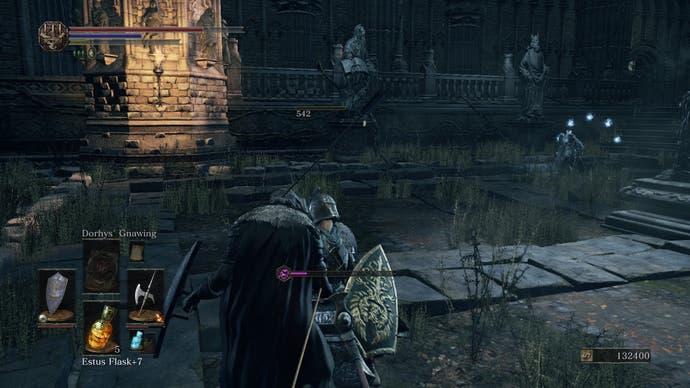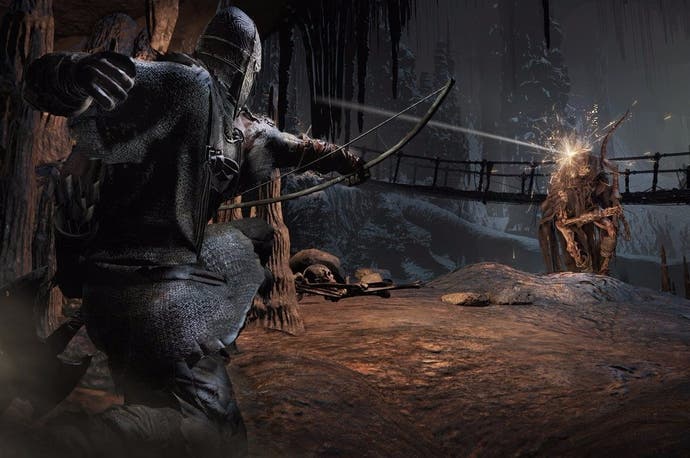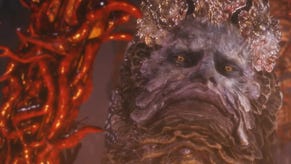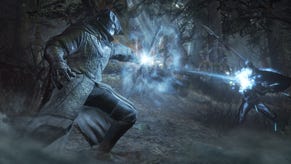Dark Souls 3 review
Third time's the charm.
Editor's note: Dark Souls 3 releases worldwide today, so to mark the occasion here's our review of From Software's farewell to its fantasy universe, first published last week.
In an industry built on sequels there are plenty of also-rans - those that fail to move on, those that change too much, and those that can't handle the expectation. Though it would be harsh to call Dark Souls 2 a failure all three of these factors played a part in its final form, with the anxiety of influence leaving it, for many players, feeling hollow. Similar opinions must be held behind From Software's doors, else how to explain the return of Hidetaka Miyazaki to the Souls series as director? The fantasy genre has form, at least, with third acts about the return of the king.
One of the player's first significant accomplishments in Dark Souls 3 is finding a much-changed Firelink Shrine, indicating the more direct relationship with Dark Souls that will be borne out over this epic journey. At the core of Dark Souls 2 was a message about repetition, about how cycles can become ever-diminishing and ever-further from their source, and in so doing it shifted focus from the world created by Dark Souls towards its own distorted reflection of same. It's not a bad concept, as these things go, but Dark Souls 3 has no such compunctions. This is surprisingly direct and aggressive with what has gone before, to the extent it feels like From Software wants to definitively cap the series.
Dark Souls was a world where history had already happened over hundreds of years, and you as the Chosen Undead were learning about it by picking through the debris. In Dark Souls 3 this long-term wear and tear is applied to the Lordran we knew. Firelink Shrine is the first of what will be many environmental callbacks, each bearing the weight of centuries and many changed beyond recognition. Some areas have been built-upon, layers of stone swaddling the original architecture nearly beyond recognition, while others have been looted or transplanted over the years, and relics of the world past are in new homes.

One is treated as an opportunity, a second chance to get it right. The lost kingdom of Izalith is crucial to Dark Souls' world, but the area itself ended up relatively bare and rushed - a huge lava floor filled with placeholder enemies followed by a small settlement and the worst boss in the game. Dark Souls 3 re-imagines Izalith as it should have been, a descending stone labyrinth riven with fire and heat, filled with the detritus of ancient war. Rooms are piled with the corpses of demons, former citizens are now so feral they move on all fours, and intricate corridors criss-cross each other with countless dead ends and hidden routes. You push on to find goat-like pyromancers lurking around corners and blasting fire from huge distances and, if you can find them, there are even yet remnants of the black knights charged with holding back the flood.
The black knights also introduce one of Dark Souls 3's more curiously prevalent tactics - for a first run-through, at least. In several sections you can drag different types of enemy together and, with a bit of luck, get them fighting. Enemies have always been able to suffer collateral damage in the Souls games but this was more about AoE attacks from bosses. Here it's not a foolproof strategy, because aggro-ing multiple enemies is always risky, but there are many opportunities to do it with tough enemies - in the case of the black knights, one can be used to take out or at least weaken an especially bothersome clutch of pyromancers, while deeper in Izalith another can provide invaluable assistance against a lethal NPC. Such additions are not game-changers, but they're welcome for allowing players to get cute in some especially-deadly situations.
Most of us will need it. There are surprises in how From Software has approached Dark Souls 3 and one is the incredible challenge it offers, to the extent an early patch toning certain elements down would be no surprise. I know these games well but, even allowing for ring-rust, was simply knocked flat by many enemies and bosses time and again. Part of this is Dark Souls 3 working with a familiar combat system, and several returning enemy types, which has led to an increase in what it expects from the player. Later enemies are relentless and clumped in groups so it's not uncommon to be simply harried to death, boxed-in by constant blows or unseen assailants, and mercilessly finished-off every time you go for a panic chug of health-giving Estus.
The big reason behind this increase in enemy aggression, I would hazard, is Bloodborne. The greatest game of 2015, also developed by From Software and directed by Hidetaka Miyazaki, was a Souls-alike, in the sense of sharing the same foundation but using this to create a much more offensive combat system based around transforming ('trick) weapons. Bloodborne's battles are fluid, intense, and tremendously exciting - as an arch in-game description notes, "shields are nice, but not if they engender passivity." And it's in this context that Dark Souls 3 returns to the classic sword-and-shield combat of the Souls games.

Rather than worrying about matching Bloodborne on aggressive play, then, From Software has made defensive strategy more nuanced, rewarding and unforgiving than it ever has been. Several changes are immediately apparent. The over-fussy parry animation of Dark Souls 2 has been replaced with the original's crisp, instantaneous shield flicks - and simpler critical hit animations. The parry timings feel tighter, but partly this is down to the more relentless onslaughts enemies unleash alongside their wonderful attack animations - full of delicious, devilish little pauses and fakes to throw you off.
This context also limits the effectiveness of turtling, though it's still a viable strategy. The dodge-roll's invincibility frames are your first and best defensive option, but these enemies are better are tracking mistimed rolls and more cautious of cheap backstabs, while their punishes are lethal. The game's opening hours are gentler, though everything's relative, but in the latter stages Dark Souls 3 is set up to give all but the very best a pummelling.
Nowhere is this more apparent than the bosses, a diverse gauntlet of bruisers, magic-users, and one-off set-pieces that challenge every side of the player's approach. The earliest bosses are neutered to give new players a chance to acclimatise, with huge wind-ups and plenty of opportunities to use Estus, but Dark Souls 3 soon begins serving up classic fight after classic fight, some riffing on themes of old and most entirely new. A welcome surprise is how well-used the 'gimmick' fights are, a hit-and-miss element of the series that here is used sparingly to powerful effect. But the best thing is how much the later boss fights, the most spectacularly dangerous enemies From Software can come up with, focus on basic fighting technique.
The Dancer of the Boreal Valley, for example, is a portmanteau of ideas typical of how Dark Souls 3 approaches the series' past. This boss is unmistakably modelled on Ciaran, a Dark Souls NPC that fought using a set of silver and gold curved blades called tracers. They were weapons that, as Miyazaki said at the time, suggested a certain image of their user. Ciaran was a side character in Dark Souls but her spiritual heir brings this image to life, combining pirouetting dance techniques with wickedly sudden swings and impacts - the deadly flashes of gold and silver distracting your eye as the blade hits home from another angle. This fight is simply about defending and attacking at the right moments yet, such is the physical and visual onslaught, keeping calm is the real challenge.
A theme for these bosses is visual spectacle, which Souls has always had but never in such an effect-laden manner. While fighting the Curse-rotted Greatwood, a giant tree that seems to be weak in the genitals, it literally brings the house down. Pontiff Sulyvahn is fought in a huge chapel and alternates between weapons, with the great fiery arcs of his sword crashing through pews and lecterns as you dive for safety. A later fight atop a bridge casts you against another spiritual heir to a series favourite, resplendent in chrome, whose blows crackle and shake the screen with their power - and who is joined midway through battle by dragons either side of the arena that begin to rain down fire. It can leave you breathless.

A special mention, finally, for the Prince Lothric fight, a pure sword battle that often seems anything but. A truism about the Souls games is that the red bar isn't so important as the green bar: that is, a player with 1hp can still fight and dodge, but a player with no stamina is a sitting duck. The Lothric fight is all about testing this, facing the player against a ferocious and seemingly-unstoppable opponent that requires absolute mastery of the stamina bar to defeat. Blocking alone will quickly see it depleted, and relying solely on dodges is a steep learning curve, so in this attritional battle you need to use both and still have the energy to swing (and get away) when there's an opening. I must have died 20 times before beating this guy, and by the final few fights my relationship with the stamina bar was at the zen level. I knew not just when to roll but when to sidestep instead (saving stamina), when to slide a quick hit in during certain of his combos, and each stamina-chewing block that was forced felt like a strategic failure. When I finally beat him I only had to heal once. That's the kind of satisfaction you just can't buy.
Perhaps the most divisive characteristic of Dark Souls 3 will be the bombast. Demon's Souls and to a lesser extent Dark Souls were mysterious, with moments of great contemplative beauty scattered throughout their forbidding worlds. Dark Souls 3 doesn't have anything ethereal about it, with even the lore seeming a little too explicit, and the world is painted in much firmer strokes. There are many extraordinary environments, and the centrepiece of Lothric Castle is stunning, but the problem is not so much anything Dark Souls 3 does or doesn't do as what it is. This is intended as a conclusion, the climax of one of the finest trilogies gaming has ever seen, and this fact precludes the atmosphere of those earlier worlds.
Dark Souls 3 ties up certain threads that might have been better left to speculation and, in a wider sense, indulges in fan service. Many characters from both earlier games return, either in literal or spiritual form, and the latter are frankly much better. It's a mystery why Andre the blacksmith is now installed at Firelink Shrine, much less why after such a fantastical transplant he's given such boring lines. One of the old Firekeepers from Dark Souls 2, meanwhile, now keeps shop and talks in a diction that comes across as a parody of Souls-speak. "Knowest thou of that soppy gossip? That cordial intrusion layeth the path to embers. And so thou art in need of a soapstone, ashen one." Right.
This is a question of taste but I find Dark Souls 3 lacking in poetry, the ambiguous but memorable lines and descriptions that can inspire days and weeks of thought about their possibilities. The language in the Souls series always had archaic elements, but never at the expense of meaning. "If substantiation be thy want, set thine eyes upon my charred corse" is needlessly over-written when plainer words would give the sense much more power. There are countless exceptions to this, especially the items relating to Aldrich which bring me out in shudders, but in a broader sense this is again not so much to do with the writing and everything to do with the well-worn grooves of an established style.

Dark Souls 3 explains many things directly and, in eagerness to include what's gone before, has something to say about many important characters or events that, arguably, diminishes rather than exalts them. Some may prefer this approach, while new players will scarcely notice anything amiss. I find it tolerable but only because certain endings for familiar characters - such as that Aldrich story - really showcase Miyazaki's talent for the psychologically macabre, while more oblique inheritances are nearly all wonderful. Other aspects seem only there for the sake of the reference. It's hard to avoid thinking that the publisher behind the appalling taint of Slashy Souls may be behind crowd-pleasers like this, as well as the constant Praise the Sun-ing, but the damage is at least kept slight.
The same sadly cannot be said for an unwelcome Dark Souls legacy - framerate drops. Dark Souls 3 features some astounding vistas and huge open environments, some of which it has trouble handling. An enormous swamp is the first time you'll see it struggle to cope, but the worst offender is Castle Lothric - which is more or less the climactic environmental challenge, utterly beautiful, and has significant drops throughout. (Digital Foundry has had an early look at the final console code, and will be looking at the PC version in the not too distant future.)
In addition to this, on a handful of occasions enemies either glitched into the scenery or ended up floating in mid-air. Once, I escaped from an enemy onto an elevator only to have them fall through the elevator's 'solid' roof onto my head. On another occasion, the game lost the online connection and returned to title menu while I was at the Blacksmith - when I returned, my Dragon Crest shield had reverted from +4 to +3 but the 8 twinkling titanite spent on it was gone. From Software games do not typically release with such ugly problems.
These faults are real and should not be ignored, but are ultimately dwarfed by Dark Souls 3's vision. This feels like the biggest Souls game by a distance, not just in terms of sheer scale but in the achievement of delivering a kind of 'ultimate' Souls experience. Old hands may grouse about this not being quite as pure or unusual an experience as the earlier games but, in truth, the Souls series has transitioned from niche hit into mainstream blockbuster with only the slightest of compromises.
The fact is that From Software own the action RPG genre to such an extent that the only valid comparison is with themselves - not a single other studio can match the quality or rate of production of the four Souls games and Bloodborne. Dark Souls 3 bears the hallmarks of a mighty heave to bring closure, from creatives who have long since mastered their tools and style.
This is a truly epic journey, from your first faltering steps across gloomy cliffs to striding like a lord-slayer through Lothric Castle. Like all epics it has endless diversions, quarrels, unexpected companions, and great big fights. Is it the finest Souls game yet? I don't know; it might be. I can say this, though: Dark Souls 3 is a fabulous game, and a fitting conclusion to the greatest trilogy of modern times.








